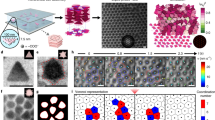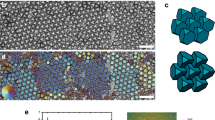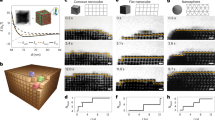Abstract
Colloidal nanoplatelets are atomically flat, quasi-two-dimensional sheets of semiconductor that can exhibit efficient, spectrally pure fluorescence. Despite intense interest in their properties, the mechanism behind their highly anisotropic shape and precise atomic-scale thickness remains unclear, and even counter-intuitive for commonly studied nanoplatelets that arise from isotropic crystal structures (such as zincblende CdSe and lead halide perovskites). Here we show that an intrinsic instability in growth kinetics can lead to such highly anisotropic shapes. By combining experimental results on the synthesis of CdSe nanoplatelets with theory predicting enhanced growth on narrow surface facets, we develop a model that explains nanoplatelet formation as well as observed dependencies on time and temperature. Based on standard concepts of volume, surface and edge energies, the resulting growth instability criterion can be directly applied to other crystalline materials. Thus, knowledge of this previously unknown mechanism for controlling shape at the nanoscale can lead to broader libraries of quasi-two-dimensional materials.
This is a preview of subscription content, access via your institution
Access options
Access Nature and 54 other Nature Portfolio journals
Get Nature+, our best-value online-access subscription
$29.99 / 30 days
cancel any time
Subscribe to this journal
Receive 12 print issues and online access
$259.00 per year
only $21.58 per issue
Buy this article
- Purchase on Springer Link
- Instant access to full article PDF
Prices may be subject to local taxes which are calculated during checkout




Similar content being viewed by others
References
Yin, Y. & Alivisatos, A. P. Colloidal nanocrystal synthesis and the organic–inorganic interface. Nature 437, 664–670 (2005).
Xia, Y. N., Xiong, Y. J., Lim, B. & Skrabalak, S. E. Shape-controlled synthesis of metal nanocrystals: simple chemistry meets complex physics? Angew. Chem. 48, 60–103 (2009).
Murray, C. B., Norris, D. J. & Bawendi, M. G. Synthesis and characterization of nearly monodisperse CdE (E = sulfur, selenium, tellurium) semiconductor nanocrystallites. J. Am. Chem. Soc. 115, 8706–8715 (1993).
Peng, X. et al. Shape control of CdSe nanocrystals. Nature 404, 59–61 (2000).
Manna, L., Milliron, D. J., Meisel, A., Scher, E. C. & Alivisatos, A. P. Controlled growth of tetrapod-branched inorganic nanocrystals. Nat. Mater. 2, 382–385 (2003).
Manna, L., Scher, E. C. & Alivisatos, A. P. Synthesis of soluble and processable rod-, arrow-, and teardrop-, and tetrapod-shaped CdSe nanocrystals. J. Am. Chem. Soc. 122, 12700–12706 (2000).
Milliron, D. J. et al. Colloidal nanocrystal heterostructures with linear and branched topology. Nature 430, 190–195 (2004).
Liu, L. et al. Shape control of CdSe nanocrystals with zinc blende structure. J. Am. Chem. Soc. 131, 16423–16429 (2009).
Joo, J., Son, J. S., Kwon, S. G., Yu, J. H. & Hyeon, T. Low-temperature solution-phase synthesis of quantum well structured CdSe nanoribbons. J. Am. Chem. Soc. 128, 5632–5633 (2006).
Ithurria, S. & Dubertret, B. Quasi 2D colloidal CdSe platelets with thicknesses controlled at the atomic level. J. Am. Chem. Soc. 130, 16504–16505 (2008).
Ithurria, S. et al. Colloidal nanoplatelets with two-dimensional electronic structure. Nat. Mater. 10, 936–941 (2011).
Tyagi, P., Arveson, S. M. & Tisdale, W. A. Colloidal organohalide perovskite nanoplatelets exhibiting quantum confinement. J. Phys. Chem. Lett. 6, 1911–1916 (2015).
Bekenstein, Y., Koscher, B. A., Eaton, S. W., Yang, P. & Alivisatos, A. P. Highly luminescent colloidal nanoplates of perovskite cesium lead halide and their oriented assemblies. J. Am. Chem. Soc. 137, 16008–16011 (2015).
Akkerman, Q. A. et al. Solution synthesis approach to colloidal cesium lead halide perovskite nanoplatelets with monolayer-level thickness control. J. Am. Chem. Soc. 138, 1010–1016 (2016).
Shamsi, J. et al. Colloidal synthesis of quantum confined single crystal CsPbBr3 nanosheets with lateral size control up to the micrometer range. J. Am. Chem. Soc. 138, 7240–7243 (2016).
Schliehe, C. et al. Ultrathin PbS sheets by two-dimensional oriented attachment. Science 329, 550–553 (2010).
Liu, Y.-H., Wang, F., Wang, Y., Gibbons, P. C. & Buhro, W. E. Lamellar assembly of cadmium selenide nanoclusters into quantum belts. J. Am. Chem. Soc. 133, 17005–17013 (2011).
Achtstein, A. W. et al. Electronic structure and exciton–phonon interaction in two-dimensional colloidal CdSe nanosheets. Nano Lett. 12, 3151–3157 (2012).
Pelton, M., Ithurria, S., Schaller, R. D., Dolzhnikov, D. S. & Talapin, D. V. Carrier cooling in colloidal quantum wells. Nano Lett. 12, 6158–6163 (2012).
Rowland, C. E. et al. Picosecond energy transfer and multiexciton transfer outpaces Auger recombination in binary CdSe nanoplatelet solids. Nat. Mater. 14, 484–489 (2015).
Guzelturk, B., Erdem, O., Olutas, M., Kelestemur, Y. & Demir, H. V. Stacking in colloidal nanoplatelets: tuning excitonic properties. ACS Nano 8, 12524–12533 (2014).
Olutas, M. et al. Lateral size-dependent spontaneous and stimulated emission properties in colloidal CdSe nanoplatelets. ACS Nano 9, 5041–5050 (2015).
Yeltik, A. et al. Experimental determination of the absorption cross-section and molar extinction coefficient of colloidal CdSe nanoplatelets. J. Phys. Chem. C 119, 26768–26775 (2015).
She, C. et al. Low-threshold stimulated emission using colloidal quantum wells. Nano Lett. 14, 2772–2777 (2014).
Chen, Z., Nadal, B., Mahler, B., Aubin, H. & Dubertret, B. Quasi-2D colloidal semiconductor nanoplatelets for narrow electroluminescence. Adv. Funct. Mater. 24, 295–302 (2014).
Lhuillier, E. et al. Electrolyte-gated field effect transistor to probe the surface defects and morphology in films of thick CdSe colloidal nanoplatelets. ACS Nano 8, 3813–3820 (2014).
Ithurria, S., Bousquet, G. & Dubertret, B. Continuous transition from 3D to 1D confinement observed during the formation of CdSe nanoplatelets. J. Am. Chem. Soc. 133, 3070–3077 (2011).
Hutter, E. M. et al. Conformal and atomic characterization of ultrathin CdSe platelets with a helical shape. Nano Lett. 14, 6257–6262 (2014).
Wang, F. et al. Two-dimensional semiconductor nanocrystals: properties, templated formation, and magic-size nanocluster intermediates. Acc. Chem. Res. 48, 13–21 (2015).
Son, J. S. et al. Large-scale soft colloidal template synthesis of 1.4 nm thick CdSe nanosheets. Angew. Chem. Int. Ed. 48, 6861–6864 (2009).
Wang, Y. et al. The magic-size nanocluster (CdSe)34 as a low-temperature nucleant for cadmium selenide nanocrystals: room-temperature growth of crystalline quantum platelets. Chem. Mater. 26, 2233–2243 (2014).
Mahler, B., Nadal, B., Bouet, C., Patriarche, G. & Dubertret, B. Core/shell colloidal semiconductor nanoplatelets. J. Am. Chem. Soc. 134, 18591–18598 (2012).
Harrison, W. & Trotter, J. Crystal and molecular structure of cadmium diacetate dihydrate. J. Chem. Soc. Dalton Trans. 956–960 (1972).
Chen, D., Gao, Y., Chen, Y., Ren, Y. & Peng, X. Structure identification of two-dimensional colloidal semiconductor nanocrystals with atomic flat basal planes. Nano Lett. 15, 4477–4482 (2015).
Nasilowski, M., Mahler, B., Lhuillier, E., Ithurria, S. & Dubertret, B. Two-dimensional colloidal nanocrystals. Chem. Rev. 116, 10934–10982 (2016).
Bouet, C. et al. Two-dimensional growth of CdSe nanocrystals, from nanoplatelets to nanosheets. Chem. Mater. 25, 639–645 (2013).
Mirnaya, T. A. & Volkov, S. V. in Green Industrial Applications of Ionic Liquids (eds Rogers, R. D., Seddon, K. R. & Volkov, S. V.) 439–456 (Springer, 2002).
Tessier, M. D. et al. Efficient exciton concentrators built from colloidal core/crown CdSe/CdS semiconductor nanoplatelets. Nano Lett. 14, 207–213 (2013).
Li, Z. et al. Uniform thickness and colloidal-stable CdS quantum disks with tunable thickness: synthesis and properties. Nano Res. 5, 337–351 (2012).
Pedetti, S. et al. Optimized synthesis of CdTe nanoplatelets and photoresponse of CdTe nanoplatelets films. Chem. Mater. 25, 2455–2462 (2013).
Lovette, M. A. et al. Crystal shape engineering. Ind. Eng. Chem. Res. 47, 9821–9833 (2008).
Ohara, M. & Reid, R. C. Modeling Crystal Growth Rates from Solution (Prentice-Hall, 1973).
Thanh, N. T. K., Maclean, N. & Mahiddine, S. Mechanisms of nucleation and growth of nanoparticles in solution. Chem. Rev. 114, 7610–7630 (2014).
Scott, R. et al. Temperature dependent radiative and non-radiative recombination dynamics in CdSe-CdTe and CdTe-CdSe type II hetero nanoplatelets. Phys. Chem. Chem. Phys. 18, 3197–3203 (2016).
Fichthorn, K. A. & Weinberg, W. H. Theoretical foundations of dynamical Monte Carlo simulations. J. Chem. Phys. 95, 1090–1096 (1991).
Hung, A., Muscat, J., Yarovsky, I. & Russo, S. P. Density-functional theory studies of pyrite FeS2(100) and (110) surfaces. Surf. Sci. 513, 511–524 (2002).
Weber, B., Betz, R., Bauer, W. & Schlamp, S. Crystal structure of iron(II) acetate. Z. Anorg. Allg. Chem. 637, 102–107 (2011).
Protesescu, L. et al. Nanocrystals of cesium lead halide perovskites (CsPbX3, X = Cl, Br, and I): novel optoelectronic materials showing bright emission with wide color gamut. Nano Lett. 15, 3692–3696 (2015).
Perdew, J. P., Burke, K. & Ernzerhof, M. Generalized gradient approximation made simple. Phys. Rev. Lett. 77, 3865–3868 (1996).
Kresse, G. & Hafner, J. Ab initio molecular dynamics for liquid metals. Phys. Rev. B 47, 558–561 (1993).
Kresse, G. & Furthmüller, J. Efficient iterative schemes for ab initio total-energy calculations using a plane-wave basis set. Phys. Rev. B 54, 11169–11186 (1996).
Ott, F. D., Spiegel, L. L., Norris, D. J. & Erwin, S. C. Microscopic theory of cation exchange in CdSe nanocrystals. Phys. Rev. Lett. 113, 156803 (2014).
Acknowledgements
This work was supported by ETH Research Grant ETH-38 14-1, by the Swiss National Science Foundation under Grant Nos 200021-140617 and 200020-159228, and by the US Office of Naval Research (ONR) through the Naval Research Laboratory’s Basic Research Program (SCE). F.D.O. benefited from an ONR Global travel grant. S.J.P.K. acknowledges funding from the European Research Council under the European Union’s Seventh Framework Programme (FP/2007-2013)/ERC Grant Agreement No. 339905 (QuaDoPS Advanced Grant). Computations were performed at the ETH High-Performance Computing Cluster Euler and the DoD Major Shared Resource Center at AFRL. We thank A. Sánchez-Ferrer for assistance with the X-ray scattering measurements and R. Mezzenga for equipment access. We acknowledge L. Frenette, O. Hirsch, P. Kumar, D. Koziej, V. Lin, M. Mazzotti, K. McNeill, S. Meyer, M. Niederberger, F. Rabouw, A. Rossinelli, H. Schönberg, O. Waser, C. Willa, F. Rechberger and M. Bärtsch for technical assistance and discussions. We utilized the ScopeM facility at ETH Zurich for electron microscopy.
Author information
Authors and Affiliations
Contributions
A.R., F.D.O., S.C.E. and D.J.N. conceived the experiments and model. Syntheses and optical spectroscopy were performed by A.R., A.M. and P.N.K. X-ray diffraction, differential scanning calorimetry, nuclear magnetic resonance spectroscopy, electron microscopy and energy-dispersive X-ray spectroscopy were carried out by A.R. and P.N.K. Polarized optical and fluorescence microscopy was performed by A.R. with help from S.J.P.K. and F.P. Calculations and simulations were performed by F.D.O. and S.M. The NPL growth model was developed by F.D.O. and S.C.E. with input from A.R. and D.J.N. Both S.C.E. and D.J.N. supervised the work. A.R., F.D.O., S.C.E. and D.J.N. wrote the manuscript. All authors contributed to the discussion of the results and to the revision of the manuscript.
Corresponding authors
Ethics declarations
Competing interests
The authors declare no competing financial interests.
Supplementary information
Supplementary Information
Supplementary Information (PDF 12178 kb)
Supplementary Information
Supplementary Movie 1 (MP4 1110 kb)
Supplementary Information
Supplementary Movie 2 (MP4 3250 kb)
Rights and permissions
About this article
Cite this article
Riedinger, A., Ott, F., Mule, A. et al. An intrinsic growth instability in isotropic materials leads to quasi-two-dimensional nanoplatelets. Nature Mater 16, 743–748 (2017). https://doi.org/10.1038/nmat4889
Received:
Accepted:
Published:
Issue Date:
DOI: https://doi.org/10.1038/nmat4889
This article is cited by
-
A reactivity-controlled epitaxial growth strategy for synthesizing large nanocrystals
Nature Synthesis (2023)
-
Halide-guided active site exposure in bismuth electrocatalysts for selective CO2 conversion into formic acid
Nature Catalysis (2023)
-
Two-dimensional halide perovskites: A review on their orientations
Science China Physics, Mechanics & Astronomy (2023)
-
Ligand-induced, magic-size clusters enabled formation of colloidal all-inorganic II–VI nanoplatelets with controllable lateral dimensions
Nano Research (2023)
-
Double-crowned 2D semiconductor nanoplatelets with bicolor power-tunable emission
Nature Communications (2022)



